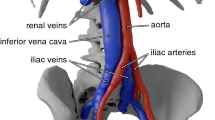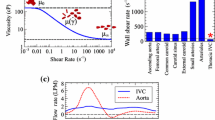Abstract
Embolus transport simulations are performed to investigate the dependence of inferior vena cava (IVC) filter embolus-trapping performance on IVC anatomy. Simulations are performed using a resolved two-way coupled computational fluid dynamics/six-degree-of-freedom approach. Three IVC geometries are studied: a straight-tube IVC, a patient-averaged IVC, and a patient-specific IVC reconstructed from medical imaging data. Additionally, two sizes of spherical emboli (3 and 5 mm in diameter) and two IVC orientations (supine and upright) are considered. The embolus-trapping efficiency of the IVC filter is quantified for each combination of IVC geometry, embolus size, and IVC orientation by performing 2560 individual simulations. The predicted embolus-trapping efficiencies of the IVC filter range from 10 to 100%, and IVC anatomy is found to have a significant influence on the efficiency results (\(P < 0.0001\)). In the upright IVC orientation, greater secondary flow in the patient-specific IVC geometry decreases the filter embolus-trapping efficiency by 22–30 percentage points compared with the efficiencies predicted in the idealized straight-tube or patient-averaged IVCs. In a supine orientation, the embolus-trapping efficiency of the filter in the idealized IVCs decreases by 21–90 percentage points compared with the upright orientation. In contrast, the embolus-trapping efficiency is insensitive to IVC orientation in the patient-specific IVC. In summary, simulations predict that anatomical features of the IVC that are often neglected in the idealized models used for benchtop testing, such as iliac vein compression and anteroposterior curvature, generate secondary flow and mixing in the IVC and influence the embolus-trapping efficiency of IVC filters. Accordingly, inter-subject variability studies and additional embolus transport investigations that consider patient-specific IVC anatomy are recommended for future work.







Similar content being viewed by others
References
Acconcia E, Verrillo M, Kramer K, Severinsen K (2015) Large-scale study on vein filter use launches (PRESERVE). Society of Interventional Radiology (703), Fairfax
Alkhouli M, Morad M, Narins CR, Raza F, Bashir R (2016) Inferior vena cava thrombosis. JACC Cardiovasc Interv 9(7):629–643
Aycock KI, Campbell RL, Manning KB, Sastry SP, Shontz SM, Lynch FC, Craven BA (2014) A computational method for predicting inferior vena cava filter performance on a patient-specific basis. J Biomech Eng 136(8):1–13
Aycock KI, Campbell RL, Lynch FC, Manning KB, Craven BA (2016) The importance of hemorheology and patient anatomy on the hemodynamics in the inferior vena cava. Ann Biomed Eng 44(12):3568–3582
Aycock KI, Campbell RL, Manning KB, Craven BA (2017) A resolved two-way coupled CFD/6-DOF approach for predicting embolus transport and the embolus-trapping efficiency of IVC filters. Biomech Model Mechanobiol. 16(3):851–869. doi:10.1007/s10237-016-0857-3
Carrier M, Righini M, Wells P, Perrier A, Anderson D, Rodger M, Pleasance S, Le Gal G (2010) Subsegmental pulmonary embolism diagnosed by computed tomography: incidence and clinical implications. a systematic review and meta-analysis of the management outcome studies. J Thromb Haemost 8(8):1716–1722
Chaikof EL, Fillinger MF, Matsumura JS, Rutherford RB, White GH, Blankensteijn JD, Bernhard VM, Harris PL, Kent KC, May J, Veith FJ, Zarins CK (2002) Identifying and grading factors that modify the outcome of endovascular aortic aneurysm repair. J Vasc Surg 35(5):1061–1066
Chan WS, Spencer FA, Ginsbergm JS (2010) Anatomic distribution of deep vein thrombosis in pregnancy. Can Med Assoc J 182(7):657–660
Cheng CP, Herfkens RJ, Taylor CA (2003) Inferior vena caval hemodynamics quantified in vivo at rest and during cycling exercise using magnetic resonance imaging. Am J Physiol Heart Circ Physiol 284(4):H1161–H1167
Chien S (1970) Shear dependence of effective cell volume as a determinant of blood viscosity. Science 168(3934):977–979
Cipolla J, Weger NS, Sharma R, Schrag SP, Sarani B, Truitt M, Lorenzo M, Sims CA, Kim PK, Torigian D, Temple-Lykens B, Sicoutris CP, Stawicki SP (2008) Complications of vena cava filters: a comprehensive clinical review. OPUS 12 Sci 2(2):11–24
DCS Computing GmbH (2015) LIGGGHTS public documentation, version 3.1.0
Di Renzo A, Di Maio FP (2004) Comparison of contact-force models for the simulation of collisions in dem-based granular flow codes. Chem Eng Sci 59(3):525–541
Dowell JD, Wagner D, Elliott E, Yildiz VO, Pan X (2016) Factors associated with advanced inferior vena cava filter removals: a single-center retrospective study of 203 patients over 7 years. Cardiovasc Intervent Radiol 39(2):218–226
Ferziger JH, Peric M (2012) Computational methods for fluid dynamics. Springer, Berlin
Funaki B (2006) Inferior vena cava filter insertion. Semin Interv Radiol 23(04):357–360
Hager A (2014) CFD-DEM on multiple scales: an extensive investigation of particle-fluid interactions. Ph.D. Thesis, Technisch-Naturwissenschaftliche Fakultät
Hager A, Kloss C, Pirker S, Goniva C (2014) Parallel resolved open source CFD-DEM: method, validation and application. J Comput Multiph Flows 6:13–27
Hammer FD, Rousseau HP, Joffre FG, Sentenac BP, Tran-Van T, Barthelemy RP (1994) In vitro evaluation of vena cava filters. J Vasc Interv Radiol 5(6):869–876
Ikesaka R, Carrier M (2015) Clinical significance and management of subsegmental pulmonary embolism. J Thromb Thrombolysis 39(3):311–314
Jaeger HJ, Kolb S, Mair T, Geller M, Christmann A, Kinne RKH, Mathias KD (1998) In vitro model for the evaluation of inferior vena cava filters: effect of experimental parameters on thrombus-capturing efficacy of the Vena Tech-LGM filter. J Vasc Interv Radiol 9(2):295–304
Katsamouris AA, Waltman AC, Delichatsios MA, Athanasoulis CA (1988) Inferior vena cava filters: in vitro comparison of clot trapping and flow dynamics. Radiology 166(2):361–366
Kaufman JA, Waltman AC, Rivitz SM, Geller SC (1995) Anatomical observations on the renal veins and inferior vena cava at magnetic resonance angiography. Cardiovasc Interv Radiol 18(3):153–157
Laborda A, Sierre S, Malve M, De Blas I, Ioakeim I, Kuo WT, De Gregorio MA (2014) Influence of breathing movements and valsalva maneuver on vena caval dynamics. World J Radiol 6(10):833–839
Laborda A, Kuo WT, Ioakeim I, De Blas I, Malvè M, Lahuerta C, De Gregorio MA (2015) Respiratory-induced haemodynamic changes: a contributing factor to IVC filter penetration. Cardiovasc Interv Radiol 38(5):1192–1197
Lee SW, Steinman DA (2007) On the relative importance of rheology for image-based CFD models of the carotid bifurcation. J Biomech Eng 129(2):273–278
Lorch H, Dallmann A, Zwaan M, Weiss HD (2002) Efficacy of permanent and retrievable vena cava filters: experimental studies and evaluation of a new device. Cardiovasc Interv Radiol 25(3):193–199
Mismetti P, Laporte S, Pellerin O, Ennezat PV, Couturaud F, Elias A, Falvo N, Meneveau N, Quere I, Roy PM, Sanchez O, Schmidt J, Seinturier C, Sevestre MA, Beregi JP, Tardy B, Lacroix P, Presles E, Leizorovicz A, Decousus H, Barral FG, Meyer G (2015) Effect of a retrievable inferior vena cava filter plus anticoagulation vs anticoagulation alone on risk of recurrent pulmonary embolism. JAMA 313(16):1627
Mukherjee D, Padilla J, Shadden SC (2016) Numerical investigation of fluid-particle interactions for embolic stroke. Theor Comput Fluid Dyn 30(1):23–29
Nahirnyak VM, Yoon SW, Holland CK (2006) Acousto-mechanical and thermal properties of clotted blood. J Acoust Soc Am 119(6):3766–3772
Newcombe RG (1998) Two-sided confidence intervals for the single proportion: comparison of seven methods. Stat Med 17(8):857–872
Nicolás M, Malvè M, Peña E, Martínez MA, Leask R (2015a) In vitro comparison of Günther Tulip and Celect filters: testing filtering efficiency and pressure drop. J Biomech 48:504–511
Nicolás M, Palero VR, Pena E, Arroyo MP, Martinez MA, Malve M (2015b) Numerical and experimental study of the fluid flow through a medical device. Int Commun Heat Mass Transf 61:170–178
Oguzkurt L, Ozkan U, Ulusan S, Koc Z, Tercan F (2008) Compression of the left common iliac vein in asymptomatic subjects and patients with left iliofemoral deep vein thrombosis. J Vasc Interv Radiol 19(3):366–370
PREPIC Study Group (2005) Eight-year follow-up of patients with permanent vena cava filters in the prevention of pulmonary embolism: the PREPIC (prevention du risque d’embolie pulmonaire par interruption cave) randomized study. Circulation 112(3):416–422
Qian Z, Yasui K, Nazarian GK, Vlodaver Z, Hunter DW, Castaneda-Zuniga WR, Amplatz K (1994) In vitro and in vivo experimental evaluation of a new vena caval filter. J Vasc Interv Radiol 5(3):513–518
Rahbar E, Mori D, Moore JE (2011) Three-dimensional analysis of flow disturbances caused by clots in inferior vena cava filters. J Vasc Interv Radiol 22(6):835–842
Robinson JD, Madison MT, Hunter DW, Castaneda-Zuniga WR, Amplatz K (1988) In vitro evaluation of caval filters. Cardiovasc Interv Radiol 3:156–168
Robinson RA, Herbertson LH, Sarkar Das S, Malinauskas RA, Pritchard WF, Grossman LW (2013) Limitations of using synthetic blood clots for measuring in vitro clot capture efficiency of inferior vena cava filters. Med Devices (Auckl) 6:49–57
Seo T, Schachter LG, Barakat AI (2005) Computational study of fluid mechanical disturbance induced by endovascular stents. Ann Biomed Eng 33(4):444–456
Singer MA, Wang SL (2011) Modeling blood flow in a tilted inferior vena cava filter: does tilt adversely affect hemodynamics? J Vasc Interv Radiol 22(2):229–235
Singer MA, Henshaw WD, Wang SL (2009) Computational modeling of blood flow in the TrapEase inferior vena cava filter. J Vasc Interv Radiol 20(6):799–805
Singer MA, Wang SL, Diachin DP (2010) Design optimization of vena cava filters: an application to dual filtration devices. J Biomech Eng 132(10): 101006. doi:10.1115/1.4002488
Stewart SFC, Robinson RA, Nelson RA, Malinauskas RA (2008) Effects of thrombosed vena cava filters on blood flow: flow visualization and numerical modeling. Ann Biomed Eng 36(11):1764–1781
Stoneham GW, Burbridge BE, Millward SF (1995) Temporary inferior vena cava filters: in vitro comparison with permanent IVC filters. J Vasc Interv Radiol 6(5):731–736
Swaminathan TN, Hu HH, Patel AA (2006) Numerical analysis of the hemodynamics and embolus capture of a Greenfield vena cava filter. J Biomech Eng-T ASME 128(3):360–370
Teo TK, Angle JF, Shipp JI, Bluett MK, Gilliland CA, Turba UC, Matsumoto AH (2011) Incidence and management of inferior vena cava filter thrombus detected at time of filter retrieval. J Vasc Interv Radiol 22(11):1514–1520
Thijs W, Rabe KF, Rosendaal FR, Middeldorp S (2010) Predominance of left-sided deep vein thrombosis and body weight. J Thromb Haemost 8(9):2083–2084
Wang SL, Singer MA (2010) Toward an optimal position for inferior vena cava filters: computational modeling of the impact of renal vein inflow with Celect and TrapEase filters. J Vasc Interv Radiol 21(3):367–374
Whitcome KK, Shapiro LJ, Lieberman DE (2007) Fetal load and the evolution of lumbar lordosis in bipedal hominins. Nature 450(7172):1075–1078
Xian ZY, Roy S, Hosaka J, Kvernebo K, Lærum F (1995) Multiple emboli and filter function: an in vitro comparison of three vena cava filters. J Vasc Interv Radiol 6(6):887–893
Acknowledgements
We thank Yao Huang and Nathaniel D. Porter for helpful discussions on the statistical analysis. This work used the Extreme Science and Engineering Discovery Environment (XSEDE), which is supported by National Science Foundation Grant No. ACI-1053575.
Funding This research was supported by the Walker Assistantship program at The Pennsylvania State Applied Research Laboratory.
Author information
Authors and Affiliations
Corresponding authors
Ethics declarations
Conflict of interest
The authors declare that they have no conflict of interest.
Electronic supplementary material
Below is the link to the electronic supplementary material.
Supplementary material 1 (mp4 5485 KB)
Supplementary material 2 (mp4 4392 KB)
Supplementary material 3 (mp4 712 KB)
Supplementary material 4 (mp4 4721 KB)
Supplementary material 5 (mp4 3671 KB)
Rights and permissions
About this article
Cite this article
Aycock, K.I., Campbell, R.L., Lynch, F.C. et al. Computational predictions of the embolus-trapping performance of an IVC filter in patient-specific and idealized IVC geometries. Biomech Model Mechanobiol 16, 1957–1969 (2017). https://doi.org/10.1007/s10237-017-0931-5
Received:
Accepted:
Published:
Issue Date:
DOI: https://doi.org/10.1007/s10237-017-0931-5




